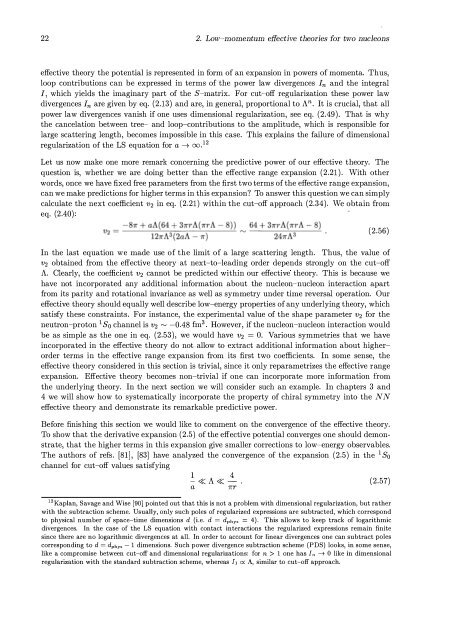The Nucleon-Nucleon Interaction in a Chiral Effective Field Theory
The Nucleon-Nucleon Interaction in a Chiral Effective Field Theory
The Nucleon-Nucleon Interaction in a Chiral Effective Field Theory
You also want an ePaper? Increase the reach of your titles
YUMPU automatically turns print PDFs into web optimized ePapers that Google loves.
22 2. Low-momentum effective theories for two nucleons<br />
effective theory the potential is represented <strong>in</strong> form of an expansion <strong>in</strong> powers of momenta. Thus,<br />
loop contributions can be expressed <strong>in</strong> terms of the power law divergences In and the <strong>in</strong>tegral<br />
I, which yields the imag<strong>in</strong>ary part of the S-matrix. For cut-off regularization these power law<br />
divergences In are given by eq. (2.13) and are, <strong>in</strong> general, proportional to A n . It is crucial, that all<br />
power law divergences vanish if one uses dimensional regularization, see eq. (2.49). That is why<br />
the cancelation between tree- and loop-contributions to the amplitude, which is responsible for<br />
large scatter<strong>in</strong>g length, becomes impossible <strong>in</strong> this case. This expla<strong>in</strong>s the failure of dimensional<br />
regularization of the L8 equation for a ---+ 00. 12<br />
Let us now make one more remark concern<strong>in</strong>g the predictive power of our effective theory. <strong>The</strong><br />
question is, whether we are do<strong>in</strong>g better than the effective range expansion (2.21). With other<br />
words, once we have fixed free parameters from the first two terms of the effective range expansion,<br />
can we make predictions for higher terms <strong>in</strong> this expansion? To answer this quest ion we can simply<br />
calculate the next coefficient V2 <strong>in</strong> eq. (2.21) with<strong>in</strong> the cut-off approach (2.34). We obta<strong>in</strong> from<br />
eq. (2.40):<br />
(2.56)<br />
In the last equation we made use of the limit of a large scatter<strong>in</strong>g length. Thus, the value of<br />
V2 obta<strong>in</strong>ed from the effective theory at next-to-lead<strong>in</strong>g order depends strongly on the cut-off<br />
A. Clearly, the coefficient V2 cannot be predicted with<strong>in</strong> our effective theory. This is because we<br />
have not <strong>in</strong>corporated any additional <strong>in</strong>formation about the nucleon-nucleon <strong>in</strong>teraction apart<br />
from its parity and rotational <strong>in</strong>variance as weIl as symmetry under time revers al operation. Our<br />
effective theory should equally weIl describe low-energy properties of any underly<strong>in</strong>g theory, which<br />
satisfy these constra<strong>in</strong>ts. For <strong>in</strong>stance, the experimental value of the shape parameter V2 for the<br />
neutron-proton 1 So channel is V2 rv -0.48 fm3. However, if the nucleon-nucleon <strong>in</strong>teraction would<br />
be as simple as the one <strong>in</strong> eq. (2.53), we would have V2 = O. Various symmetries that we have<br />
<strong>in</strong>corporated <strong>in</strong> the effective theory do not allow to extract additional <strong>in</strong>formation about higherorder<br />
terms <strong>in</strong> the effective range expansion from its first two coefficients. In some sense, the<br />
effective theory considered <strong>in</strong> this section is trivial, s<strong>in</strong>ce it only reparametrizes the effective range<br />
expansion. <strong>Effective</strong> theory becomes non-trivial if one can <strong>in</strong>corporate more <strong>in</strong>formation from<br />
the underly<strong>in</strong>g theory. In the next section we will consider such an example. In chapters 3 and<br />
4 we will show how to systematically <strong>in</strong>corporate the property of chiral symmetry <strong>in</strong>to the N N<br />
effective theory and demonstrate its remarkable predictive power.<br />
Before f<strong>in</strong>is h<strong>in</strong>g this section we would like to comment on the convergence of the effective theory.<br />
To show that the derivative expansion (2.5) of the effective potential converges one should demonstrate,<br />
that the higher terms <strong>in</strong> this expansion give sm aller corrections to low-energy observables.<br />
<strong>The</strong> authors of refs. [81], [83] have analyzed the convergence of the expansion (2.5) <strong>in</strong> the 1 S0 channel for cut-off values satisfy<strong>in</strong>g<br />
1 4<br />
- « A « - .<br />
(2.57)<br />
a Kr<br />
12 Kaplan, Savage and Wise [90] po<strong>in</strong>ted out that this is not a problem with dimensional regularization, but rather<br />
with the subtraction scheme. Usually, only such poles of regularized expressions are subtracted, which correspond<br />
to physical number of space-time dimensions d (i.e. d = dphys = 4). This allows to keep track of logarithmic<br />
divergences. In the case of the LS equation with contact <strong>in</strong>teractions the regularized expressions rema<strong>in</strong> f<strong>in</strong>ite<br />
s<strong>in</strong>ce there are no logarithmic divergences at all. In order to account for l<strong>in</strong>ear divergences one can subtract poles<br />
correspond<strong>in</strong>g to d = dphys - 1 dimensions. Such power divergence subtraction scheme (PDS) looks, <strong>in</strong> some sense,<br />
like a compromise between cut-off and dimensional regularizations: for n > 1 one has In --7 ° like <strong>in</strong> dimensional<br />
regularization with the standard subtraction scheme, whereas h cx A, similar to cut-off approach.












